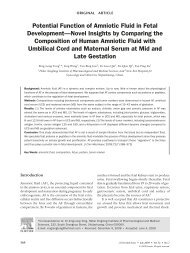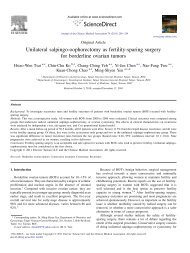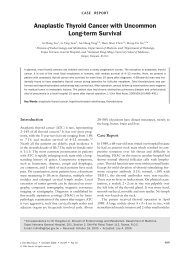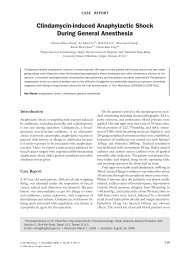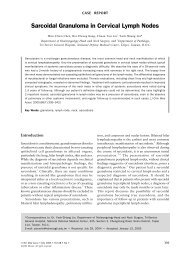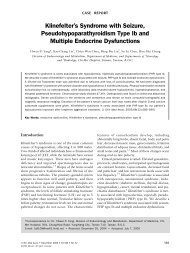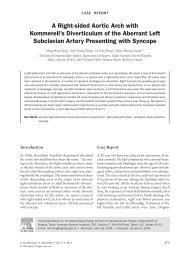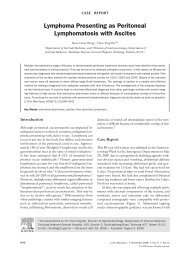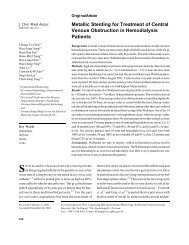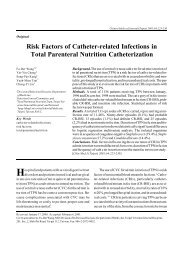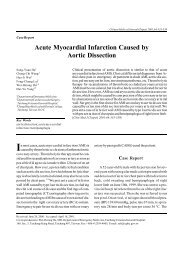Surgical Anatomy of Supratentorial Midline Lesions
Surgical Anatomy of Supratentorial Midline Lesions
Surgical Anatomy of Supratentorial Midline Lesions
You also want an ePaper? Increase the reach of your titles
YUMPU automatically turns print PDFs into web optimized ePapers that Google loves.
20. Marino R Jr: The anterior cerebral artery: I-Anatomo-radiological study <strong>of</strong> its cortical territories. Surg Neurol 5:81-87, 1976. Bibliographic<br />
Links Document Delivery Library Holdings [Context Link]<br />
21. Milhorat TH, Baldwin M: A technique for surgical exposure <strong>of</strong> the cerebral midline: Experimental transcallosal microdissection.J Neurosurg<br />
24:687-691, 1966. Bibliographic Links Document Delivery Library Holdings [Context Link]<br />
22. Milisavljevic S, Marinkovic S, Lolic-Draganic V, Djordjevic L: Anastomoses in the territory <strong>of</strong> the posterior cerebral arteries.Acta Anat<br />
127:221-225, 1986. Bibliographic Links Document Delivery Library Holdings [Context Link]<br />
23. Perlmutter D, Rhoton AL Jr: Microsurgical anatomy <strong>of</strong> the anterior cerebral-anterior communicating-recurrent artery complex. J Neurosurg<br />
45:259-272, 1976. [Context Link]<br />
24. Perlmutter D, Rhoton AL Jr: Microsurgical anatomy <strong>of</strong> the distal anterior cerebral artery. J Neurosurg 49:204-228, 1978. [Context Link]<br />
25. Rhoton AL Jr, Yamamoto I, Peace DA: Microsurgery <strong>of</strong> the third ventricle: Part 2-Operative approaches. Neurosurgery 8:357-373, 1981.<br />
Bibliographic Links Document Delivery Library Holdings [Context Link]<br />
26. Ring BA, Waddington MM: Roentgenographic anatomy <strong>of</strong> the pericallosal arteries. Am J Roentgenol 104:109-118, 1968. [Context Link]<br />
27. Salamon G, Huang YP: Radiologic <strong>Anatomy</strong> <strong>of</strong> the Brain. New York, Springer-Verlag, 1976. [Context Link]<br />
28. Timurkaynak E, Rhoton AL Jr, Barry M: Microsurgical anatomy and operative approaches to the lateral ventricles.Neurosurgery 19:685-723,<br />
1986. Bibliographic Links Document Delivery Library Holdings [Context Link]<br />
29. Vincentelli F, Lehman G, Caruso G, Grisoli F, Rabehanta B, Gouaze A: Extracerebral course <strong>of</strong> the perforating branches <strong>of</strong> the anterior<br />
communicating artery: Microsurgical anatomical study. Surg Neurol 35:98-104, 1991. Bibliographic Links Document Delivery Library<br />
Holdings [Context Link]<br />
30. Williams PL: Nervous system, in Gray's <strong>Anatomy</strong>. New York, Churchill-Livingstone, 1995, ed 38, pp 901-1397. [Context Link]<br />
31. Wolfram-Gabel R, Maillot C, Koritke JG: Vascularisation arterielle du corps calleux chez l'homme. Arch Anat Histol Embryol 72:43-55,<br />
1989. Bibliographic Links Document Delivery Library Holdings [Context Link]<br />
32. Yamamoto I, Kageyama N: Microsurgical anatomy <strong>of</strong> the pineal region. J Neurosurg 53:205-221, 1980. [Context Link]<br />
33. Yamamoto I, Rhoton AL Jr, Peace DA: Microsurgery <strong>of</strong> the third ventricle: Part I-Microsurgical anatomy. Neurosurgery 8:334-356, 1981.<br />
[Context Link]<br />
34. Yasargil MG: Operative anatomy, inMicroneurosurgery. Stuttgart, Georg Thieme Verlag, 1984, vol 1, pp 5-168. [Context Link]<br />
35. Yasargil MG: Intrinsic tumors: Topographical aspects, inMicroneurosurgery. Stuttgart, Georg Thieme Verlag, 1996, vol 4B, pp 237-342.<br />
[Context Link]<br />
36. Zeal AA, Rhoton AL Jr: Microsurgical anatomy <strong>of</strong> the posterior cerebral artery. J Neurosurg 48:534-559, 1978. Bibliographic Links<br />
Document Delivery Library Holdings [Context Link]<br />
COMMENTS<br />
The authors have completed an excellent study <strong>of</strong> the arteries <strong>of</strong> the corpus callosum, which is further enhanced by the illustrations. The<br />
anatomy described here will be useful in operative approaches directed along the whole medial surface <strong>of</strong> the hemisphere from the subfrontal<br />
area all the way back to the occipital region. The authors have provided an especially clear description <strong>of</strong> the perforating arteries arising from the<br />
anterior communicating artery (ACoA). These studies document that it is best to direct transcallosal approaches between the pericallosal arteries<br />
rather than on the lateral side <strong>of</strong> the arteries, which will lead to interruption <strong>of</strong> branches <strong>of</strong> the callosal arteries.<br />
Albert L. Rhoton, Jr.<br />
Gainesville, Florida<br />
The authors dissect 20 brains with injected arteries and study and measure the larger and smaller arteries to the corpus callosum and<br />
surrounding structures. Many <strong>of</strong> the measurements and descriptions have also been described in different articles from our Institute. I compare<br />
the results <strong>of</strong> both study groups and give some examples.<br />
In the material <strong>of</strong> Türe et al., the distance measured between the ACoA and the lamina terminalis is 4 mm (range, 1-9 mm); in our material<br />
it is 4.9 mm (range, 0-10 mm). Türe et al. found 2.5 (range, 1-6) perforating branches <strong>of</strong> the ACoA; we found 3 (range, 0-10). The diameters<br />
were measured by Türe et al., together with arteries to the corpus callosum; in our material, the measurements were taken only to the



